#Northwestern Salamander
Text
"The Yurok will be the first Tribal nation to co-manage land with the National Park Service under a historic memorandum of understanding signed on Tuesday [March 19, 2024] by the tribe, Redwood national and state parks, and the non-profit Save the Redwoods League, according to news reports.
The Yurok tribe has seen a wave of successes in recent years, successfully campaigning for the removal of a series of dams on the Klamath River, where salmon once ran up to their territory, and with the signing of a new memorandum of understanding, the Yurok are set to reclaim more of what was theirs.
Save the Redwoods League bought a property containing these remarkable trees in 2013, and began working with the tribe to restore it, planting 50,000 native plants in the process. The location was within lands the Yurok once owned but were taken during the Gold Rush period.
Centuries passed, and by the time it was purchased it had been used as a lumber operation for 50 years, and the nearby Prairie Creek where the Yurok once harvested salmon had been buried.
Currently located on the fringe of Redwoods National and State Parks which receive over 1 million visitors every year and is a UNESCO Natural Heritage Site, the property has been renamed ‘O Rew, a Yurok word for the area.
“Today we acknowledge and celebrate the opportunity to return Indigenous guardianship to ‘O Rew and reimagine how millions of visitors from around the world experience the redwoods,” said Sam Hodder, president and CEO of Save the Redwoods League.
Having restored Prarie Creek and filled it with chinook and coho salmon, red-legged frogs, northwestern salamanders, waterfowl, and other species, the tribe has said they will build a traditional village site to showcase their culture, including redwood-plank huts, a sweat house, and a museum to contain many of the tribal artifacts they’ve recovered from museum collections.
Believing the giant trees sacred, they only use fallen trees to build their lodges.
“As the original stewards of this land, we look forward to working together with the Redwood national and state parks to manage it,” said Rosie Clayburn, the tribe’s cultural resources director.
It will add an additional mile of trails to the park system, and connect them with popular redwood groves as well as new interactive exhibits.
“This is a first-of-its-kind arrangement, where Tribal land is co-stewarded with a national park as its gateway to millions of visitors. This action will deepen the relationship between Tribes and the National Park Service,” said Redwoods National Park Superintendent Steve Mietz, adding that it would “heal the land while healing the relationships among all the people who inhabit this magnificent forest.”"
-via Good News Network, March 25, 2024
#indigenous#land back#indigenous issues#first nations#native american#indigenous peoples#yurok#yurok tribe#national parks service#national park#redwoods#california#trees#trees and forests#united states#good news#hope#indigenous land
4K notes
·
View notes
Text
I love when my friends tag me in shit on Facebook and are like “COLBY WHAT IS THIS”!! Like honestly it gives me the greatest joy. It’s always fish videos/pictures too. Like they know I’ll know exactly what it is, or will be able to figure it out so easily.
Just my little boost of serotonin from my friends.
#honestly I smile like an idiot every time#last one was the tiktok of the puppy going after the salamander#they were like Colby you like fish and water creatures#wtf is that#and I’m like it’s a northwestern salamander they’re cool#I get videos of groupers a lot because my friends don’t think they actually get that big#and I’m like nah they totally do and can sometimes get bigger#like fuck I love fish so much
0 notes
Photo

Northwestern Salamander, 2017-12-20
1K notes
·
View notes
Text
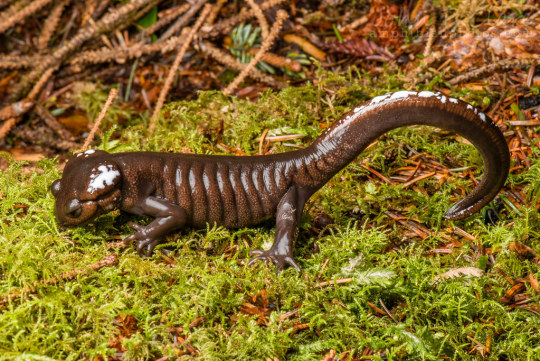
Northwestern Salamander (Ambystoma gracile), female showing defensive posture with milky whte toxic secretions, family Ambystomatidae, Del Norte County, California, USA
photograph by John P Clare
228 notes
·
View notes
Text
Cryptid Collection Spotlight: Champ
We're going to be spending this week infodumping about the six cryptids we chose to feature in our Cryptid Collection! We'll be posting about the lore and origins, our thoughts, experiences, and relationships with all of these cryptids, and we encourage folks to share their own!
Today we're talking about our home state's very own lake monster, Champ!
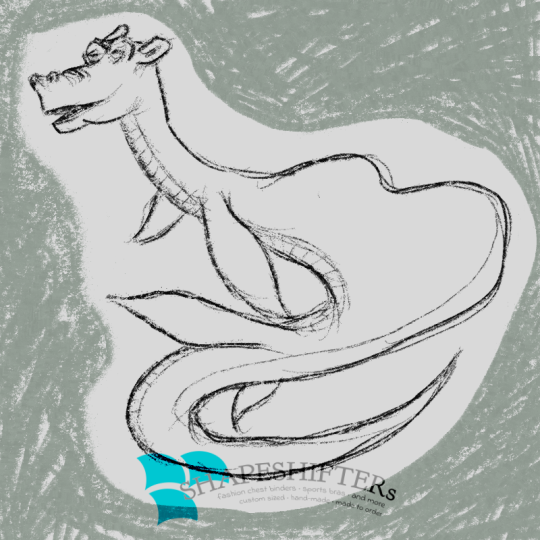
👣The Cryptid Collection
🐍Champ Travel Poster
👥Cryptid Binders & Sportsbras
🧵Cryptid fabric designs
There is no shortage of sea serpents and lake monsters all over the globe, the most famous of all them of course residing in the depths of Loch Ness in Scotland. But did you know that our home state of Vermont has its very own lake monster?
Champ, like Nessie, is named after the lake it calls home — in this case, Lake Champlain, which borders northeastern New York to the west, southern Quebec to the north, and northwestern Vermont to the east. Though while sightings of Champ have been reported up and down the shores of Lake Champlain, in Vermont, at least, it's the city of Burlington that's adopted Champ as its own.
By absolute happenstance, of the six cryptids we chose to feature in our collection, three of them have origin stories or momentous first sightings, and three of them just kind of ... exist. Champ is one of the latter. While there have been sightings of unusual marine life in Lake Champlain as far back as 1609 by the lake's modern namesake, Samuel de Champlain, there hasn't really been one explosive or momentous moment in Champ's history.
Reports of a "serpent" in Lake Champlain have come in fairly steadily every few years since around 1819, with most encounters amounting to either seeing the serpent writhing around near the surface, or simply swimming along with multiple humps and sometimes its head visible above the water. The physical descriptions have often varied from sighting to sighting. It was described by some as being silver, while others claimed it was "drab", while a Captain by the name of Crum reported to the Plattburgh Republican newspaper in 1819 that it was black with several distinct markings, including a white star on its forehead and red band around its neck. Some report spikes along its back, some horns "like those of a huge catfish", some three teeth. While, as far as size goes, it's been reported to be as short as 20 feet long, to as long as 187 feet.
So is it any wonder that debunkers over the centuries have had a hard time narrowing down just what Champ "really" is? The most common theory might be a sturgeon, other theories include catfish, seals, otters, snakes, and, in the case of a reported "baby sea serpent" caught by a Chaplain Transportation Company employee, a salamander.
Still, for all the discrepancies between the eye witness reports, Champ has continued to keep both the region's and the country's fascination since those early reports. Even P.T. Barnum got in on the action, not once but twice! In 1873, Barnum contacted a reporter at the Whitehall Times offering $50,000 (around $1.3 million today) for anyone who could provide him with "the hide of the great Champlain Serpent", plus any additional funds needed in "securing the monster's remains".
That didn't quite pan out for him, though, so fourteen years later, in 1887, he announced to a reporter in Boston that he was still very interested in being the first person to possess physical proof of "the Lake Champlain sea serpent". Though his offered reward had dropped by that point to a mere $20,000 (around $650,000 today) while expanding his requirement to "dead or alive [...] providing that the serpent is more than fifty feet in length."
A brief aside: That 1887 article closes by calling Champ "his snakeship" and I, for one, will not be referring to His Snakeship, Champ, without his proper title from now on.
Barnum never got his proof, but with the advent of photography, there have been many photos snapped of His Snakeship, Champ, particularly with the modern advent of point-and-click personal cameras. The most notable was taken by a woman named Sandra Mansi on a family vacation in 1977. It appears to show the narrow neck and bulbous head of an animal curling up out of the water and around as if to look behind it. It remains one of the clearest photographs of His Snakeship, Champ to this day. And it is still not quite clear enough to definitively prove once and for all that His Snakeship, Champ is real.
For those who believe, His Snakeship, Champ, might be a true sea serpent — a long, relatively narrow-bodied marine animal that moves through the water like an enormous snake. Or it might be a marine dinosaur that's somehow managed survive in Lake Champlain's depths for over 10,000 years, like His Snakeship, Champ's Scottish cousin Nessie — a whale-like body, four pairs of flippers, and a long tail and equally long neck.
But whatever it is, what we know for sure is that it's a true Vermonter and we couldn't create a cryptid collection without including His Snakeship, Champ.
8 notes
·
View notes
Text

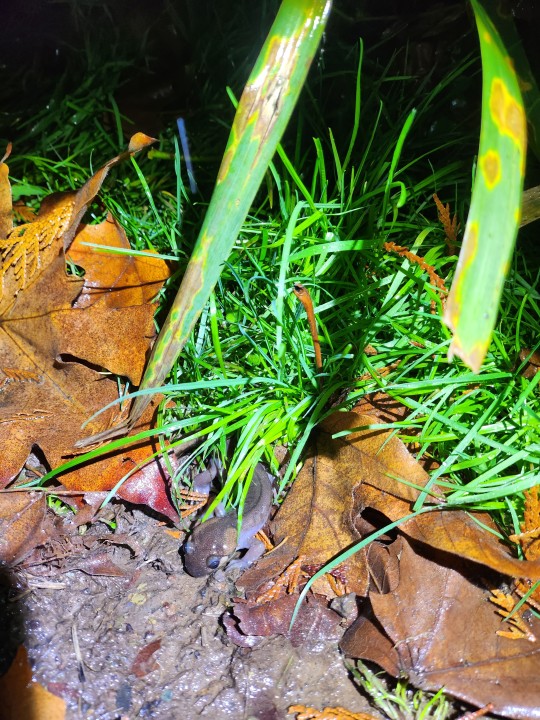
Two adult Northwestern salamanders found in Oregon.
4 notes
·
View notes
Text
Wandering Salamanders Skydive From Some of the World's Tallest Trees | Smart News
Wandering Salamanders Skydive From Some of the World’s Tallest Trees | Smart News
The skydiving wandering salamanders are native to northwestern California.
Christian Brown
When disturbed, wandering salamanders (Aneides vagrans) living in the canopies of redwood trees will take a leap of faith to branches further below. The acrobatic stunt is not a frantic and uncontrolled plunge. Instead, it is a controlled descent. The animals stretch out their tails and feet in a position…
View On WordPress
0 notes
Photo
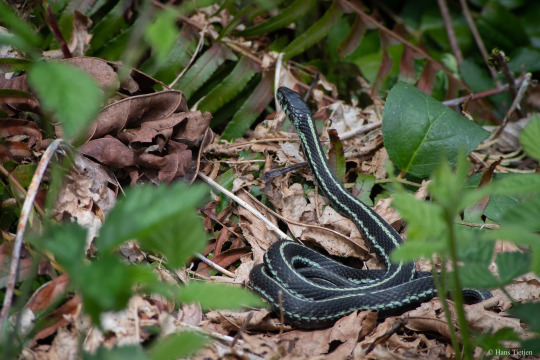

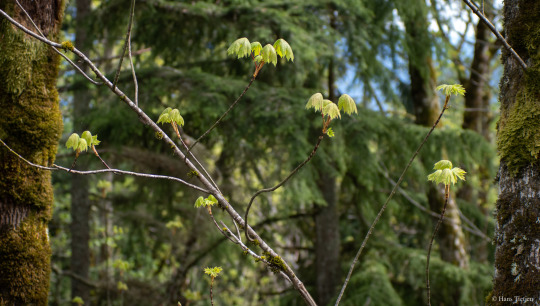

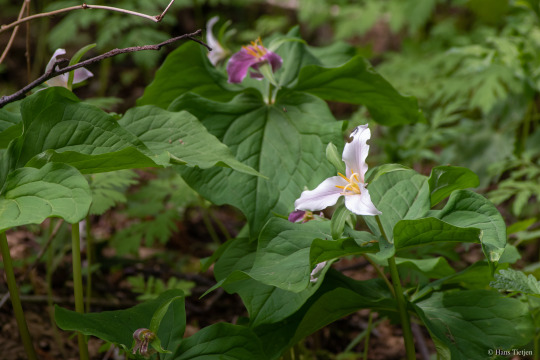


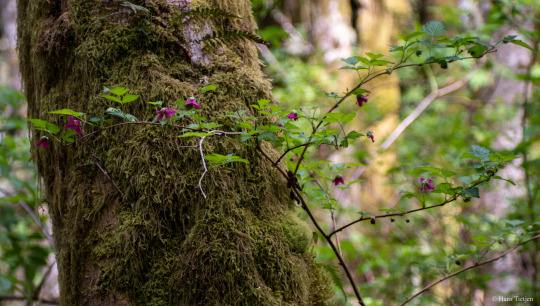
Cougar Mountain Regional Wildland Park
#Snake#Garter Snake#Salamander#Northwestern Salamander#Trillium#Salmonberry#Maple#Flowers#Plants#Green#Cougar Mountain#Cougar Mountain Regional Wildlife Park#Washington#Washington State#Pacific Northwest#Landscape Photography
8 notes
·
View notes
Photo

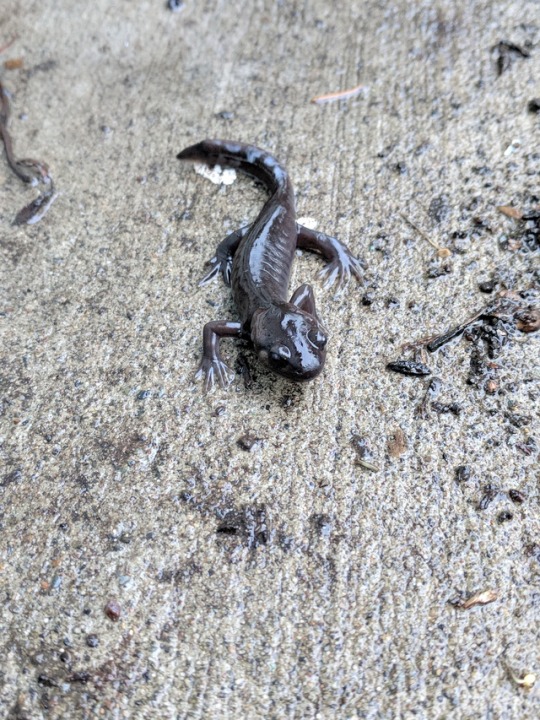

Found this guy in my front yard this weekend
0 notes
Text
Flora and Fauna of Brethil
I had these posted separately but I thought it would be easier to combine them, I’ve also added some more information!
Requested by @echoofthemusic
Flora and fauna of Arda masterlist
Disclaimer: I used both what we can extrapolate is likely indigenous to the region based on descriptions of the landscape and climate as well as my own headcanons and inspirations and reference books on similar habitats as well as books like The Atlas of Middle Earth and The Flora of Middle Earth
I really love working on and researching these! and as always feel free to ask more, even if I’ve already done a place I’d always enjoy going into more detail of tacking a more specific kind of life there
Brethil was a forested country that made up the Northwestern border of Doriath and was home to the people of the House of Haleth. It also borders Dorthonion, the land of pines. It translates to Silver birch in Sindarin.
Brethil translates to Silver Birch in Sindarin and was described as containing forests of beeches. In this world, these can be found throughout Europe. The Ancient and Primeval Beech Forest is made up of 94 parts in 18 countries. For the flora of Brethil I have taken inspiration from a number of them, especially from areas I know were of interest to Tolkien himself.
While the real world locations that make up similar climates or forests are heavily varied in their flora making it difficult to say exactly what could be found here. But needless to say we are talking about temperate broadleaf and mixed forests in a relatively cool climate.
And as the books say, beeches and birches made up the primary species. The only other plant named directly in the text as associated with Brethil are bracken ferns.
Acorns, chestnuts, walnuts, beechnuts, and hazelnuts can be collected from their respective trees.
As we know roots are foraged, chicory, dandelions, burdock root, wild carrot, and wild garlic are possibilities. Other edible plants include yarrow, hazel, thornapple, hogweed, stitchwort, and wild thyme. Both silver birches and beech trees have some edible parts.
Flowers like cornflower, columbine, Wood anemone, ramsoms, daisy, and harebell perhaps grow in less densely forested areas.
Fungi are not plants but many of the forests Tolkien was likely inspired by contain a wide variety of fungi with silverleaf fungus, Echinoderma asperum, and Meripilus giganteus being some of the most recognizable ones.
Lichen and mosses are also likely found, for example carpet moss, Atrichum undulatum and hoary fringe moss
Somewhat related, in The Wanderings of Húrin, we get a beautiful (and heartbreaking) description of how the grave of Morwen and the memorial to her children is honored by the women of Brethil.
"But until the end of Beleriand women of Brethil would come with flowers and spring and berries in autumn and sing for awhile of the Gray lady who sought in vain for her son"
It would be all but impossible to make a guess on what flowers these were but based on the description of the forests and the likely climate, blackberries, currents, elderberries and chokeberries are all possibilities, they grow in late summer and autumn.
(note that I am using the looser definition of berry rather than the strict one)
As for the fauna, typical insect life of a deciduous forest; earthworms, beetles, butterflies and moths, etc.
There’s probably a lot of birds; pheasants and quail, thrush and nuthatch, nightingale, nightjars, and owls, kestrels, crows, rooks, etc
I do wonder about the possibility of extinct, even flightless birds though no known species exactly fit this sort of habitat so perhaps on another location someone requests I’ll be able to fit them in
In the spring, vernal pools are home to frogs and salamanders. I imagine that because the main known source of water is the fast moving river, the amphibian life in Brethil is less aquatic species that prefer leaf litter and the undergrowth to permanent ponds. Toads, wood frogs, certain species of salamanders including red back salamanders.
There could possibly be wood turtles too.
Squirrels, rabbits, wood mice, moles and red foxes are possible mammals
I believe it’s mentioned somewhere that the people of Brethil keep pigs though that are not fully domesticated and are closer to wild boars.
There are probably few larger predators but bears are a possibility. Húrin does mention wolves in “The Wanderings of Húrin” but it’s somewhat unclear if this is because he has seen wolves in Brethil or if it’s more hypothetical.
Deer like fallow, roe, and elk are probably found
I like to think there are species that are extinct in the world today, perhaps like the Irish Elk, a rare sighting in Brethil as they prefer colder climates but in the spring and summer they could potentially be spotted in more open clearings and by the river.
32 notes
·
View notes
Note
Hey do you have any advice, or resources on hand for keeping leeches as pets? I have a lil predatory leech that came in with some black worms and I want to keep it, but all the resources I'm finding are short-term, like for keeping bait. Any tips? Your critters are adorable, and thank you
For non-bloodfeeding leeches the most knowledge I have for their care is from what other keepers post about them. Or the occasional scientific articles I’ve read in the past. Some people keep them in an aquarium set up and feed them a diet of fish food, an earthworm, blood worms (<— a common live food usually grown for fishes). Ribbon worms (Erpobdella obscura is a predator/scavenger) and are a common one to keep since, as you’ve mentioned, are regarded as a fish bait.
Unlike many leeches which are blood-suckers, E. punctata is a predator and scavenger. Among the invertebrates it eats are copepods, midges, earthworms and amphipods. This leech has been observed adhering to a salamander, thus being transported to a new location as well as benefiting from any food scraps discarded by the salamander. (x)
The success of the 2004 survey is attributed to selecting sites with abundant rocks and logs and vegetative growth which looked “good” for leech collecting. Five species were common to both surveys, with Alboglossiphonia and Theromyzon found in one of the surveys. (x)
The bait leech, Nephelopsis obscura, followed a 24-month life cycle in two natural ponds of northwestern Minnesota, Priem's Pond and Early's Pond. (x)
I’d recommend a freshwater (I’m assuming your worms are from a freshwater source) aquarium set up and keeping temperatures around 60 degrees F, like shown in these videos:
Colony of Haemopis sanguisuga, one having a buffet of blood worms - (X). I definitely recommend that instagram on about learning the care of many leech species
Someone’s pet ribbon leech tank - (X)
Thank you on the critter comment! And asking the question, since I’m always happy to share info out there on leech keeping facts that are otherwise not easy to find. I think leeches are the cutest things 🥺 it’s such a funny thing to have an animal regarded as horror and creepy when they’re in actuality timid, curious, simple, cute. All my leech does all day is sleep, yawn, hide if there’s vibrations or a shadow pass by, and wiggle.
#i guess some species do hop down from trees to pounce on passerbys but thats no different than what a big cat does#leeches#pet leech#leech#leech keeping#pet worm#insects#ask
12 notes
·
View notes
Photo

Behold the aposomatic posturing of the Northwestern Ring-necked Snake (Diadophis punctatus occidentalis)!
The word "aposomatic" comes from the Ancient Greek words "apo" (meaning "away") and "soma" (meaning "body.") As is the case with many animals which are either poisonous or venomous, this snake has bright colors to warn predators of its toxicity. In other words, by corkscrewing its tail and revealing its bright red undersides, this snake is saying, "Stay away from my body!"
Visitors have nothing to fear from this species however. Ring-necks are rear-fanged snakes that possess only a mildly toxic saliva that is not dangerous to humans. Rarely seen in the day, they prefer open woodlands with moist soil where they hunt for worms, slugs, small frogs and salamanders.
Note: Not all animals with aposomatic colors or behaviors contain poisons! Some practice aposomatic mimicry!
Photograph via: S. Krause | National Park Service
via: Redwood National and State Parks
#ringneck snake#snake#reptile#herpetology#animals#nature#north america#parks#public lands#national parks#science
39 notes
·
View notes
Note
iirc there are also a few coastal marine fishes with disjunct ranges that stop around cape Mendocino and pick up again around Vancouver Island. I think the kelpfishes Gibbonsia metzi and G. montereyensis might be some? Interesting to hear about the sky salamander having a similar distribution. Not sure if the fish disjunction is real or just a lack of info from the outer coasts of WA and OR tho, but maybe supports the natural dispersal hypothesis for the salamanders?
Oh thank you, this is really good to know. I know practically nothing about the marine ecology in the North Pacific. (Vibrant seas; there is so much sea life in the region, I don’t even know where to begin. I’m more familiar with terrestrial rainforest/PNW landscape,.) Off the top of my head, I know of one marine species, bat stars (Patiria miniata), which have a similarly disjunct distribution. For a long while, I have had some guesses about why some rainforest species have disjunct distribution ranges, separated, isolated in California and Vancouver Island. (Big disclaimer: I am horrible with chemistry/biochemistry. Know little about physics. Bad with technical ecology. Instead, mostly into geography, biogeography, human ecology, historical environmental change, etc. But I love salamanders and PNW geography enough to venture a couple of guesses in this case.) What do you think? I’d love to hear your thoughts.
For anyone interested, we’re talking about Aneides vagrans, a salamander endemic to the Pacific Northwest. Here’s what I said about them: Though, something about the temperate rainforest canopy that might be surprising? The “sky salamander.” Rainforest creature, a lover of fog. [...] Weirdly, there are two separate populations of this salamander, with a great distance between them. Some of these salamanders live in the rainforest of Vancouver Island. But the other population? In the redwoods forest of coastal northern California, the salamanders also permanently reside up to 95 meters above ground in the canopies of redwoods, where moss beds and epiphytic fern mats, resting in bark crevices and on redwoods branches, create refuge and provide small amphibian-friendly microhabitats in the sky. They can spend their entire life up there, in the fog. [...] If this is a coastal rainforest species, why are they living in rainforest of northern California and in the rainforest of Vancouver Island, but not in all that rainforest in between? [...] A leading theory proposed by Canadian ecologists suggests that the salamander made its way to Vancouver Island naturally, in recent centuries/millennia, by rafting on the thousands of large conifer logs that fall into northern California’s water and flow northward towards the Raincoast. (Original post about salamanders living in the canopy.)
Here’s the dilemma. (This is where the salamander lives.)


Aside from the sky salamander, there are a few other terrestrial creatures that I know of, which share a similar disjunct distribution pattern. As for animals, there is Edward’s beach moth (Anarta edwardsii), which is found in coastal California and Vancouver Island, and nowhere in-between despite all of the similar/suitable habitat. (There are some isolated records along Salish Sea coast near Mt. Vernon and Port Angeles in Washington State, to be fair.) There are many species of butterflies, which inhabit coastal dunes and oak-prairie of the Salish Sea lowlands, which are endemic to the PNW. But this Anarta species has one of the coolest disjunct distribution ranges. (Photo and map from Canadian federal government, COSEWIC.)


But the moth might not be a good comparison, because it’s more like a Mediterranean ecosystem species, rather than a rainforest species.
As for plants, Canada’s federal SARA Registry names about 25 that have disjunct populations at Vancouver Island and at milder climates farther south along the PNW/California coast: Graceful beauty ornamental onion; Clarkia purpurea viminea; Ranunculus californicus; Trifolium depauperatum; Montia howellii; Isoetes nuttallii; Woodwardia fimbriata; Vulpia pacifica; Myrica californica; Minuartia pusilla; Microseris bigelovii; and a few others.
When thinking about the disjunct populations of plants/animals living in California and Vancouver Island, I would probably distinguish between two kinds of disjunct ecosystems: (1) Creatures that live in dryland Garry oak savanna/woodland/prairie. And (2) creatures that live in temperate rainforest. I think that the disjunct populations of dryland/oak species make a little more sense, or are more obvious, while the disjunct distribution of rainforest species seem harder to interpret. The Garry oak savanna/woodland of the Salish Sea lowlands at Victoria and the Gulf Islands is in a rain shadow and experiences mild winters, and I would say the ecology is not dissimilar from Mediterranean environments of California; the oak in the Victoria area thus harbors isolated populations of other “Californian” species like endemic prairie-oak butterflies, the sharp-tailed snake (Contia tenuis) and, historically, the Pacific gophersnake (Pituophis catenifer catenifer) on a couple of the Gulf Islands offshore of Victoria. (There is also a disjunct population of Northwestern fence lizards, more typical of Nor-Cal, living on the shores of the Salish Sea.) These make more sense to me, because dry oak-prairie with Mediterranean-climate dry warm summers and mild winters are like distinct pockets of suitable habitat, easier to identify. And the corridor of oak woodland through Medford-Ashland, Willamette Valley, and the South Puget Prairies provides an avenue of dispersal into the Salish Sea lowlands and eastern Vancouver Island’s rain shadow.
But the rainforest species, like the sky salamander?
Even if the salamanders did arrive in Vancouver in the Pleistocene/early Holocene by rafting from California, there are some qualities of Vancouver Island that I think might’ve been welcoming to the salamanders.
My guesses:
1. Glacial refugia: The Brookes Peninsula (northwestern Vancouver Island) seems to have operated as a glacial refugia for terrestrial species, notably some ferns, mosses, and lichens. Canada’s SARA Registry, for material on the Brookes refugia, recommends: Shafer et al. 2010; Hebda and Haggarty 1997; Pojar 1984. (Rainforest species that used to live all across the PNW between the island and northern California may have lost their populations in Washington/Oregon, but survived on the island and in California.)
2. Mild winters and/or less snow. Northern California and the western shore of Vancouver Island may provide milder winters compared to rainforest of Cascades slopes in Washington/Oregon. I know this might sound silly, given that the western shores of Vancouver Island get completely battered by severe violent oceanic storms and are at higher latitudes than Washington/Oregon, but the western shores of Vancouver Island (being so “hyper-maritime” compared to Washington/Oregon, even more marine-influenced) receive more rain in winter, compared to winter snow in Washington/Oregon. For salamanders and mosses/lichens/ferns that can survive cold/violent wind but don’t like snow, this might be suitable for extending activity seasons.
3. Consistent year-round moisture (lots of fog in Nor-Cal which redwoods epiphyte communities access to maintain moist microclimates, and lots of liquid/rain on Vancouver Island relative to the more-seasonal precipitation of Washington/Oregon). Just guessing, but if the rainforest of Washington/Oregon is just a bit seasonal, receiving rain/moisture at specific times/seasons during the year, then the western shores of Vancouver Island and the redwoods forests of coastal northern California might receive more consistent wetness/moisture? This is probably more obvious at western Vancovuer Island, one of the wettest/rainiest places on the planet. And again, I know it might sound silly, but the redwoods in California? I know that rain is seasonal in Nor-Cal, and I know that temperatures and evapotranspiration are higher here, but the fog, the consistent fog even in summer, might partially compensate, by providing a source of moisture for salamanders and plants that would prefer to live in a wet hyper-maritime rainforest but can also manage to survive by taking advantage of fog.
Here, in the Canadian federal government’s biogeoclimatic region classifications, the western shore of Vancouver Island would pretty much be the most significant site that is simultaneously “very wet” and “hypermaritime.” Very wet = good moisture for salamanders, ferns, and moss. Hypermaritime = insulated against snowy frigid winters. (Labeled here as “VH1.”) The Great Bear Rainforest along the mainland would also be “very wet / hypermaritime” but is more mountainous and at higher latitudes, not exactly nice for the salamanders.
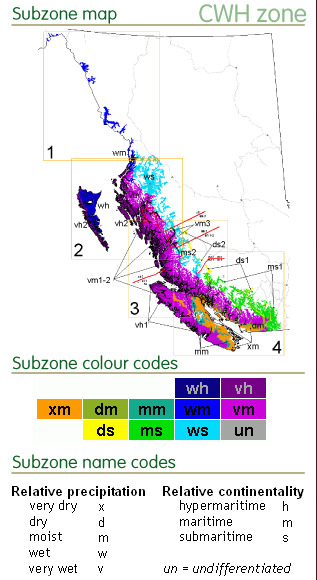
Also: canopy microclimates. As with the sky salamander, the researchers focused on these amphibians discuss how the epiphytic fern mats in redwoods (and Douglas fir) canopies collect so much moisture, and are at such high altitude relative to the forest floor, that the fern mats produce their own microclimates. Even in summer, when there is less rain, the amount of marine fog that rolls through the redwoods forest provides a source of moisture for the epiphyte communites to extract.

I also want to mention some “typical” sub-regions and classifications of the PNW rainforest, to say that I kinda think that Vancouver Island’s rainforest doesn’t get enough credit in US/EPA ecoregion classifications. I think it might make more sense to distinguish Vancouver Island’s rainforest from the rainforest of Washington/Oregon, with which it usually gets categorized as a contiguous ecoregion. I know that, typically, some ecologists/geographers would distinguish 4 sub-regions of the PNW rainforest. It seems like these distinctions were influenced by a late-1990s publication from Ecotrust (”Rainforests of Home,” mostly about salmon and watershed health).
Usually, Vancouver Island rainforest just gets lumped together with Washington/Oregon rainforest as “seasonal / mild.” So maybe it’s possible that both the California redwoods zone and western Vancouver Island are distinct from Washington/Oregon rainforest, and are similarly more-favorable for the sky salamander.


My understanding is that Vancouver Island’s rainforest is much wetter than Washington/Oregon.
I think that maps of differing rainforest soils better represent the distinction between Vancouver Island and Washington/Oregon:
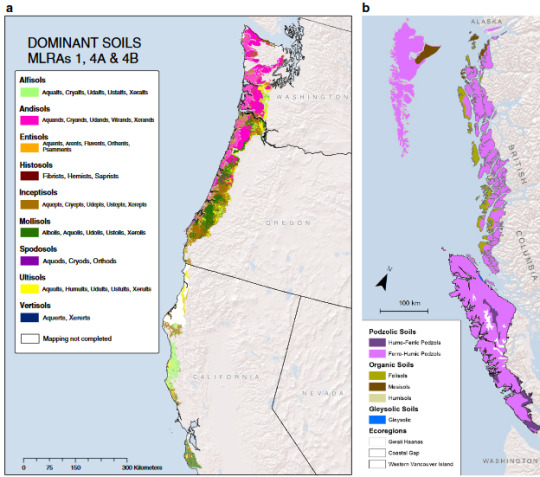
I don’t know, maybe this too:

Between the good wintertime plant hardiness of that redwoods zone and western Vancouver Island, the rainforest of Washington/Oregon might be less hospitable in winter, depending on the metrics you used to judge plant hardiness. Like, I’m not saying that western Vancouver Island’s winter season is necessarily more hospitable to plants than the Washington/Oregon rainforest farther south, but is it possible that the ferns/mosses/lichens that already live on western Vancouver Island are hardy to begin with, and also do well because of winter rain, as opposed to winter snow of the Cascades? I don’t know.
As for marine creatures, the two that I was aware of were these:
-- Eisnea arborea, a seawood, disjunct distribution at Haida/Vancouver and central California.
-- a sea star, disjunct distribution Tlingit/”Alexander” Islands, Haida, Vancouver, and central California.

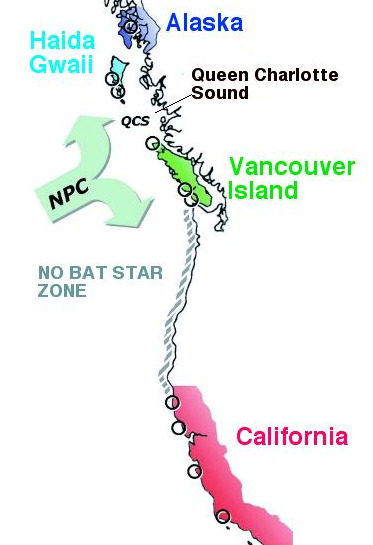
“No Bat Star Zone.” Lol.
This map from ChrisM’s “The Echinoblog.” [Good discussion of bat stars if anyone’s interested.]


Like I mentioned, there are a few other vertebrates that have a disjunct distribution, but they’re more like prairie-oak, dryland, or Mediterranean species.
Like this. (Northwestern fence lizard and sharp-tailed snake.)
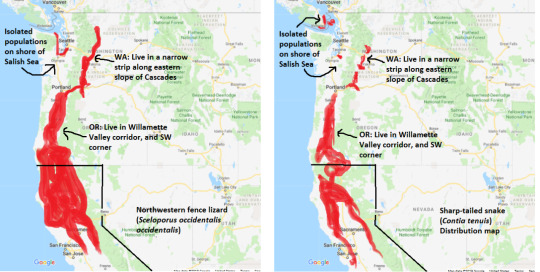
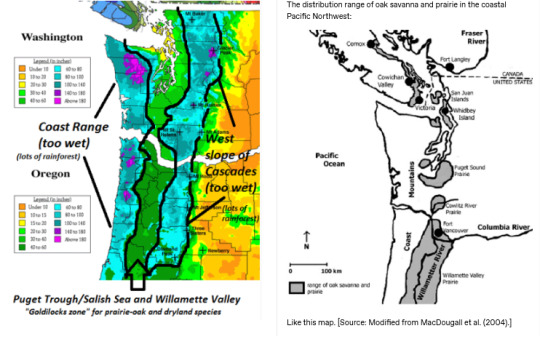
(Sorry for the shitty maps. Again, I am forced to use M!crosoft Paint, the “working-class Arc-GIS.”)
But again, I know nothing of marine biology, really. And I imagine there are so many more influences on underwater ecology here, more obscure than what happens on land.
Love these creatures, regardless.

39 notes
·
View notes
Text
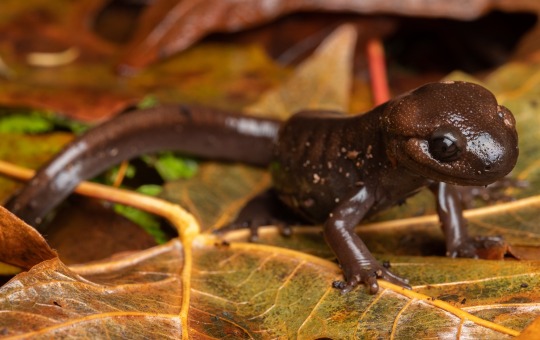
Northwestern Salamander (Ambystoma gracile), family Ambysomatidae, found in the coastal Pacific NW of North America
There are many neotenic populations of this species (neotenic salamanders retain their gills, and stay aquatic, rather than metamorphosing and going out on land). This designation only applies to salamander species that would normally metamorphose, and not those that normally stay aquatic and gilled (like waterdogs and sirens).
photograph by Andrew Nydam
261 notes
·
View notes
Text
Meet Amanda Martin, New Post-Doctoral Researcher in the Section of Amphibians and Reptiles

Hello everyone, my name is Amanda Martin and I’m a new post-doctoral researcher in the Amphibians and Reptiles section. I received both my Ph.D. and M.S. in Biological Sciences from Bowling Green State University, and my B.S. in Psychology and Interdisciplinary Studies from the State University of New York at Buffalo.
My herpetological career all started after watching Anaconda, the movie, when I was about six years old. I did not like the depiction of this wonderful creature, and since then I have been passionate about conserving and reducing other’s fear of snakes. During graduate school, I discovered that I really enjoy other amphibians and reptiles, especially the abundant red-backed salamanders which I found under logs almost every day during my research surveys. Even though I love studying snakes, I spent most of my time working with eastern box turtles using radio telemetry. One of my favorite aspects of working with these turtles is that they are easy to catch! I did, however, have some ninja turtles that liked to hide from my volunteer research assistants. Finding amphibians and reptiles can be quite challenging. I love this kind of treasure hunt because it is incredibly rewarding when you do find them!
Check out my website for more information about my previous research at: https://amandkm.wixsite.com/martin
Conservation in Action: Exploration of Changes in Land Cover over Time
In northwestern Ohio and southeastern Michigan lies a dynamic and diverse landscape, the Oak Openings Region which has been the focus of large ongoing conservation by the Green Ribbon Initiative. Over ten years ago, a land cover map was created to facilitate the enhancement and restoration of critical natural areas. Since then, local conservation partners have been changing the landscape to increase the area of natural habitats, such as upland prairie and savanna. But to see whether these efforts worked or not, they needed a new map to see these changes on the landscape. We, Martin and Root 2020, worked together with our local partners to build an updated map for region and explored these changes in land cover over a 10-year period.
We used satellite imagery and trained our model with confirmed ground sites for 14 different land cover types, including five communities of concern (swamp forest, floodplain forest, deciduous forest, upland savanna/prairie, and wet prairie). We then examined change over time by comparing total area or number of patches per land cover between the 2016 map and the 2006 map. We found that natural land covered 33% and human-modified land covered 67% of the total region. Over 10 years, natural classes increased, and cultural classes decreased in total area by 5.8%, although not all types of natural habitat increased (e.g., forest habitat decreased) and much of the natural habitat was found in small isolated pieces rather than large blocks of similar habitat. Many of these changes are likely a result of natural recovery and disturbance, and conservation efforts by the Green Ribbon Initiative. This large-scale view for conservation is needed to create conservation initiatives for different species and their natural habitats and illustrates the challenges that land managers face in restoring natural lands as humans continue to modify their surroundings.
Scientists use these types of land cover maps to better understand the interaction between species and their habitats. One aspect of this interaction is the creation of habitat suitability models, where you identify potential new habitat locations for species using occurrence data (where you find an individual) and environmental layers (land cover, elevation, distance to streams or roads, etc.). We did this for 15 target species focused on the 5 major communities of concern for Oak Openings Region using this land cover map. As Dr. Martin starts her new work with Dr. Sheridan in the amphibian and reptile section, they will be exploring this type of research utilizing the museum’s vast collection!
Link to article: https://doi.org/10.1007/s00267-020-01316-2
Journal: Environmental Management
Title: Examining Land Use Changes to Evaluate the Effects of Land Management in a Complex, Dynamic Landscape
Abstract: Anthropogenic alterations to landscapes have increased as the human population continues to rise, leading to detrimental changes in natural habitats. Ecological restoration assists in recovery by altering habitats to improve conditions and foster biodiversity. We examined land cover changes over time within a complex, dynamic region in the Midwest to assess the long-term effects of conservation. We used Landsat 8 bands for a 15-class land cover map of Oak Openings Region using supervised classification. We validated our map and achieved an overall accuracy of 71.2% from correctly classified points out of total visited points. Change over 10 years, from 2006 to 2016, was explored by comparing class statistics from FRAGSTATS between our map and original land cover map. We found that natural land, i.e., forest and early successional, covered 33%, with 10% permanently protected, while human-modified land, i.e., agricultural and developed, covered 67% of the region. Over 10 years, natural classes increased, and cultural classes decreased by 5.8%. There were decreases for the three forest communities and increases for the two early successional communities. These changes are likely the result of natural recovery and disturbance, and conservation efforts by the Green Ribbon Initiative. Changes in habitat also came with distribution changes, e.g., increased fragmentation for some classes, which was readily visible. Our useful method measured functionality by emphasizing changes in composition and configuration. Our approach provides a tool for assessing cumulative regional-scale effects from site-level management and conservation. This large-scale view for conservation is needed to effectively mitigate future changes.
#Carnegie Museum of Natural History#Amphibians and Reptiles#Snakes#Scientific Research#Land Use Changes#Biodiversity
6 notes
·
View notes
Link

All images from products founded by this Kickstarter are pre-production images and small details can change on the final product!
Explore the deeper mysteries of The Dark Eye with Magic of Aventuria and enhance your gameplay with additional rules, professions and archetypes on 240 pages! Magic of Aventuria gives you access to new magical traditions, perks and spells and gives you the background of what magic is like in Aventuria. Magic of Aventuria allows you to take complete control over the mystical art by delving into some of its strangest and most powerful practices of every kind of magic – from word, to song, to dance. Expand your magical repertoire with new traditions, spells and enchantments! Nearly two dozen profession packages expand options for starting characters and new focus rules for spell workshops allow mages to develop new and exciting spell effects!


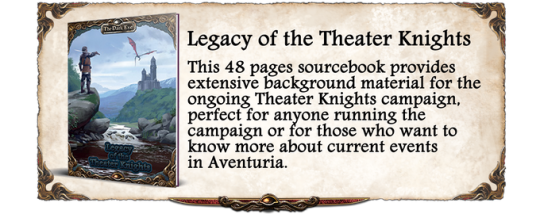




People have been playing The Dark Eye for over 30 years! It’s a well-crafted, believable medieval world created by masterful German designers native to a land of dark woods, deep mines, and high castles.
Over 30 years, those designers and a vast fan base of hundreds of thousands of players have created a rich fantasy lore without compare!
The Dark Eye (TDE) has the largest active community of any European roleplaying game. Years of gaming and stories provide a depth to the world not commonly found in other games.
The latest edition of The Dark Eye brings together decades of design refinements and player suggestions, all coordinated by a passionate and skilled team who have been playing for years.

The Dark Eye is rich, complete, and incredibly real!
Aventuria is a vast and detailed continent and a world in need of heroes. The heart of Aventuria is the Middenrealm, an empire nominally ruled by the young Empress Rohaja but in reality controlled by powerful regional lords and ladies. It is a land where knights and daring heroes fight for the order of the gods and grim dwarves delve their mines and subterranean cities deep in the mountains.
Some years ago, human servants of the dreaded archdemons conquered a province of the Middenrealm. Now called the Shadowlands, this haunted realm is home to demon summoners and necromancers. The Middenrealm remains ever vigilant for signs that the armies of the Shadowlands are once again on the move.
The progressive Horasian Empire, home to artists and poets, lies south of the Middenrealm. The cities of this fertile land are ruled by patricians, nobles, and councilors who strive constantly to outdo or weaken their rivals via intrigue.
The orcs of Aventuria make their home in the Orclands, steppes that stretch along the northwestern border of the Middenrealm.
Thorwal lies west of the Orclands. The Thorwalers are brave seafarers who enjoy a reputation as feared pirates. Emboldened by their whale-god, Swafnir, the longboats of the Thorwalers threaten much of the western coast of Aventuria.
Further south lies the Empire of Al’Anfa. Its capital of the same name, called the Boil of the South by some, is a city of decadence and intrigue where a stranger’s life is worth only what it can fetch in the slave markets.
Novadi tribes rule the huge Khôm Desert that lies east of the Horasian Empire, beyond the mountains. Even further east, sultans and emirs rule over the Lands of the Tulamydes.
The northern forests and steppes surrounding the Salamander Stones are the traditional homelands of the elves. Beloved for their beauty and grace but feared for their sometimes cruel treatment of invaders, elves are magical beings who seem to be born from light.
The Dark Eye derives its name from the most intriguing magical artifacts in Aventuria—the Dark Eyes. These rare and powerful magical items allow users to view far away places and glimpse scenes from the distant past. Creating such an artifact calls for very powerful magic and a sizable quantity of raw meteoritic iron. Few spellcasters have ever mastered the necessary enchantments. When completed successfully, the iron assumes the form of an orb or an eye.

The Dark Eye uses a unique, time-tested game system refined over decades of continuous play. The designers honed the feedback of thousands of players into the most balanced and playable version of The Dark Eye yet!
The Dark Eye incorporates module rules, as well, where general rules can be set aside for more in-depth rules when warranted by the situation. These focused rules offer more realistic options when such detail is wanted, but need not encumber the game when they are not.
The game system lets your group play any game style they prefer, be it a fun, quick dungeon crawl or a more elaborate storytelling session, or they can play The Dark Eye as an immersive simulation game. The game rules offer depth and detail, yet they are still fast to learn.
This crowdfunding offers you a unique chance to get started with The Dark Eye. Check out our special offer bundles!
Kickstarter campaign ends: Tue, June 18 2019 4:00 PM BST
Website: Ulisses Spiele
15 notes
·
View notes